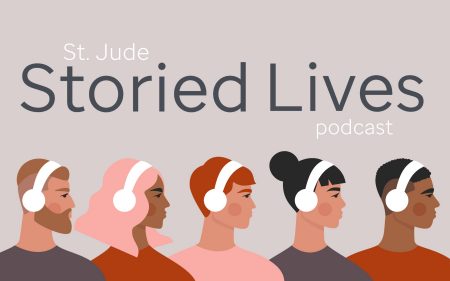
A long journey of one kind ends with long ride 'Home from St. Jude'
Sometimes, on a journey, there are roadblocks, detours and delays along the way. Cancer is like that, too.

June 08, 2022 • 11 min
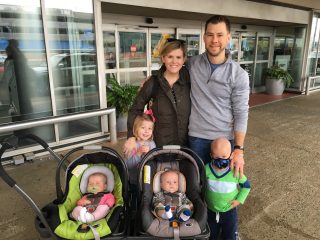
It was dark still, just after 5 a.m., as Joel loaded the last few bags into the car and looked up at the house on Mud Island near the Mississippi River in downtown Memphis one last time.
The borrowed house was a two-story, big enough for his family of six and a five-minute drive from St. Jude Children’s Research Hospital where they’d spent so much time over the last four years.
Joel studied the white pillars, rectangular windows and front porch. Leaving felt bittersweet.
“Some of the hardest seasons of our life were in that house,” he said. But the house was a place of comfort, too. A refuge from needle pokes, lab tests and beeping monitors.
It was where the kids danced in the living room after dinner and Joel and Jennings built one LEGO set after another. The kids rode bikes out back and played Wiffle ball in a nearby grassy square. It was where the twins learned to crawl.
“We had a lot of family togetherness in that house,” Joel said.
It wasn’t the first time he’d packed and said goodbye to this house he and his family had called home while his son, Jennings, now 6 years old, received treatment for leukemia at St. Jude. In 2018, they’d spent five months here while he received his first bone marrow transplant, his sister Caroline his donor.
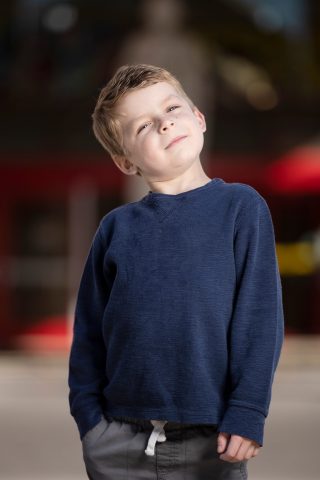
Then they went home to North Carolina, 627 miles from St. Jude and that comfortable house.
Jennings’ hair grew back, darker and coarser. He put on weight and jumped on the trampoline and ran through their wooded backyard. He was healthy for two-and-a-half years, long enough for his parents to sometimes go an entire day without thinking about cancer.
But then the cancer was back. And the family was back in Memphis. At St. Jude and the house with the view of the river.
Now, Joel buckled Jennings into his booster seat in the back seat of their blue 2006 Toyota FJ Cruiser with 230,000 miles on the odometer. He grabbed his coffee mug from the car’s roof and started the engine.
This could be the last time they’d have to make this road trip.
“It was not at all like, ‘We’ve made it. It’s over. We’re done, close-the-book kind of thing,” Joel said. He knows how quickly things could change.
“It was, ‘We’ve gotten to this point in the journey. This is the next thing,” Joel said.
“We get to go home.”
Life comes to a stop
At the intersection of Island Drive and Harbor Town Boulevard in Memphis, Joel stopped and glanced in the rear-view mirror at Jennings in his St. Jude T-shirt with a green dinosaur on the front.
Their lives, too, had come to a stop the day Jennings had been diagnosed.
Four years ago, Jennings hadn’t been his usual energetic self for months. A few times, he refused to move, crying as if he was hurt. He was sent home from preschool with a mild fever again and again.
Each time, his mom Lauren took him to the pediatrician who couldn’t find anything wrong.
Finally, when Jennings was sent home from preschool with another fever in December 2017, Lauren, who was pregnant with twins, took Jennings back to the pediatrician, insisting something was wrong.
A blood test showed Jennings’ white blood cell count was 97,000, Joel said. Normal range for children is 5,000 to 10,000.
Something was wrong.
Joel was traveling for work and about to board a plane when Lauren called. Sobbing, she could barely get the words out: “They think Jennings has leukemia.”
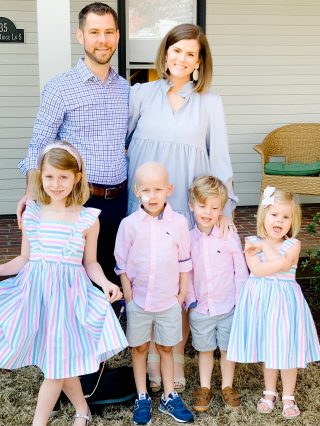
Easter Sunday in Memphis right before being admitted for transplant #1
Joel sprinted from the airport.
At the local children’s hospital that night, more tests confirmed it.
The oncologist explained leukemia is cancer of the white blood cells that starts in the bone marrow. Jennings had acute myelocytic leukemia, or AML, rarer in children and more aggressive than acute lymphoblastic leukemia, or ALL, the most common type of childhood cancer.
Later Joel and Lauren would learn ALL has a survival rate of more than 85 percent. For Jennings’ AML, it is about 70 percent.
“It was hard to take in for sure,” Joel said. “There’s not a lot of deep processing in the moment.”
In the moment, they focused on one thing: Jennings was alive. They would do whatever it took to keep him alive.
Jennings needed immediate treatment, starting the next morning with a platelet transfusion and surgery to insert a central line in his chest. The next day, Jennings began the first of three rounds of a grueling chemotherapy regimen two doses a day for 10 days.
The hope was the chemotherapy would push Jennings into remission, meaning no cancer cells in his body.
Two weeks into it, Lauren kissed her son in his hospital room and took the elevator up two floors to the maternity ward. Joel was with her for the twin’s birth and then returned to Jennings.
The next day, Lauren used a wheelchair to come back down so she could hold Jennings— whose hair was falling out in patches— while his head was shaved, knowing the buzzing clippers scared him.
Each round of chemotherapy meant 30 days in the hospital to prevent infection, a week at home in between, countless transfusions, and a nasogastric tube when Jennings couldn’t keep food down.
Grandparents helped take care of the children. Friends from church brought meals. The family celebrated Christmas at the hospital.
A bone marrow aspiration showed Jennings still had .8 percent of disease. The oncologist referred Jennings to St. Jude for a bone marrow transplant.
Joel had seen TV commercials and billboards for St. Jude. He remembers thinking, “I could never. Just never,” he said, “and then one day that’s your world.”
First transplant a tough go
Now Joel turned left on Island Drive and saw the iconic Hernando DeSoto Bridge, locally known as the “M” bridge for its double hump, lit up in the predawn duskiness, as if seeing them off.
He had a new appreciation for moments like that.
Starting out this early, they should easily make it in time for the party Lauren had planned for their arrival. It was a welcome-home party a long time in the making.
Jennings was admitted to the transplant unit at St. Jude on his 3rd birthday.
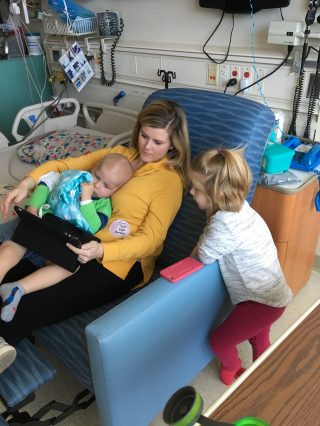
Jennings, Lauren, Caroline – receiving Caroline’s cells for transplant #1 April 2018
Joel and Lauren had explained to Caroline that Jennings’ blood was sick, and he needed her help. It was a heady discussion for a child, but 4 1/2-year-old Caroline embraced the idea. The family called the day of Jennings’ transplant, April 19, 2018, “Brother-Sister Day.”
Doctors at St. Jude took bone marrow cells from Caroline and gave them to Jennings through the central line in his chest.
New cells take weeks to grow after a transplant. Joel stayed with Jennings in the transplant unit while Lauren, caring for the twins, came as often as she could.
Jennings was weak and nauseous, vomiting often. He had to be fed through a tube.
Nurses checked on Jennings every hour, even through the night, making it tough for either of them to sleep.
“It’s a long road,” Joel said. One day ran into the next.
He entertained Jennings, reading books, putting together puzzles and playing games. Mostly, Joel held his son, when he felt sick or tired and through difficult procedures.
Joel memorized Jennings’ medicine regimen, learned to flush his central line and change dressings. He read his Bible every day, counting on science but leaning on his faith.
Friends and family offered support. Lauren’s mom came to Memphis to help with the other kids so Lauren could be with Jennings. Caroline and the twins could only see Jennings through the glass windows in a common area on the transplant unit to protect him against infection.
“It was a lot to manage and logically figure out, but we were very blessed to have what we needed to figure it out,” Joel said.
In the weeks after the transplant, Caroline’s cells made their way to Jennings’ bone marrow, where they began making new blood cells. Jennings’ white cell count went from zero to 10, and then to 30, 100, 30, and 100 again, before steadily returning to normal.
It had worked.
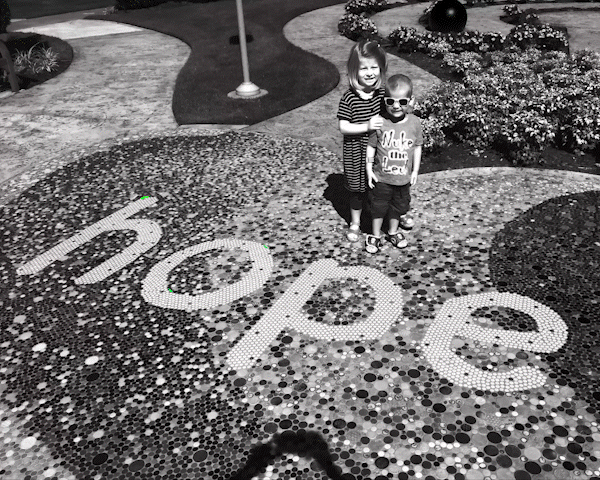
Caroline & Jennings on campus July 2018
U-turns on the road — and in life
About three hours into the trip, between Jackson and Mt. Juliet, Tennessee, traffic on Interstate 40 came to a stop.
In the backseat, Jennings played a handheld videogame he received for his 6th birthday last April. It was loaded with the same game he and his dad had borrowed from the nurses’ station at St. Jude and played for hours.
A helicopter appeared above them, heading to where a semi-truck had crashed through a guardrail, hit a column near the Mt. Juliet Road overpass and burst into flames.
Joel prayed for the people involved. “For us, the veil between this life and the next is a lot thinner than for most people,” Joel said. Most people live as if tomorrow is guaranteed.
Knowing Jennings’ mom and siblings were waiting, Joel pulled up a map on his cellphone, looking for an alternate route. He made a U-turn, carefully crossing the grass median.
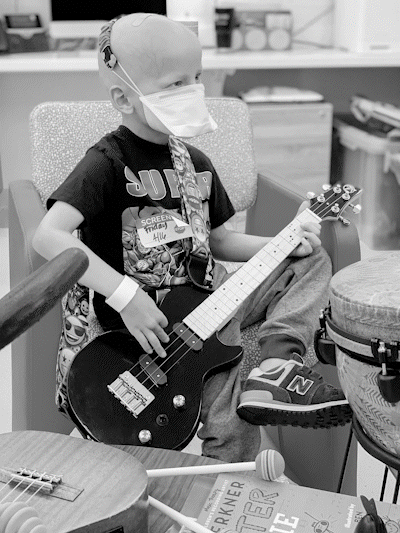
Jennings, music therapy at St. Jude
The detour meant turning around, going back the way they had come. Joel took the next exit and then followed a road north, another one east, not sure where he was headed.
Journeys sometimes are like that. There are roadblocks, detours, and delays along the way. Cancer is like that, too, the journey thwarted with roadblocks, detours, and delays a mom and dad never could have imagined.
In November 2020, Lauren had been at the park in their North Carolina neighborhood with the children when Jennings’ transplant doctor at St. Jude called, concerned about Jennings’ chimerism analysis, which measures the percentage of donor cells in a transplant recipient’s blood. It should be 100 percent.
That summer, a few of Jennings’ tests had come back at 99-100 percent.
“At the time we were kind of blissfully ignorant,” Joel said. “It had been so long we weren’t worried about it anymore.”
The risk of relapse is highest in the first few months. It had been two and a half years since Jennings’ transplant, halfway to the five-year mark when he could be considered cured.
His most recent analysis was 70 percent donor cells.
Joel took Jennings for a bone marrow aspiration at the St. Jude affiliate clinic in North Carolina, where Jennings got regular lab work done. It would give a more accurate measure than the blood test.
“We were pretty anxious and nervous about what we were going to find,” Joel said.
Typically, results aren’t available for days. They didn’t have to wait.
An oncologist came in with the results of Jennings’ blood test. His white cell count was 97,000, the same as when he was first diagnosed.
Jennings had relapsed.
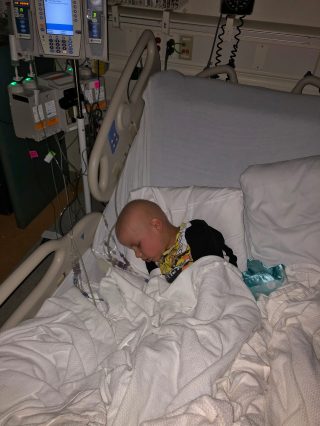
Jennings after receiving the 2nd dose of cells on the night of transplant #2, he was very sick here – heart rate & respiratory rate out of control and the Rapid Response Team was called in
“Just like that, we were plunged back into a world we were sure we had left behind,” Joel said.
They knew what was to come. Another bone marrow transplant. Another separation. More time away from home.
“We had been through this journey before, and for a relapse, there’s not any different journey,” Joel said. “It’s just hoping it works this time where it didn’t work last time.”
Lauren and Joel explained to Caroline, who was then 7, that she’d given her brother two and a half cancer-free years. This time, they would try Daddy’s cells. Joel was only a half-match, but that was close enough with a process pioneered and refined at St. Jude and used around the world.
Joel and Jennings left for St. Jude on New Year’s Eve, just the two of them, driving the same route. Lauren packed up and followed in the minivan with the three kids.
Jennings was eager to get to St. Jude. Not even halfway there, he asked, “How much longerrrrr?” At 5½, Jennings didn’t remember much about the first transplant. It was a blessing really.
“Kids really are resilient and can take a lot and can go through a lot,” Joel said. “It’s adults who fully understand and you’re watching a child go through it. We’re much less equipped than they are.”
In the blood donor center at St. Jude, Joel sat for five hours as his T blood cells were drawn from his blood in a process called apheresis.
Intravenous lines were inserted in each arm. Blood flowed out of one into a machine that separates white blood cells and stores them, and the rest of the blood pushed back through the line in his other arm.
Then, Joel’s cells were separated in a lab at St. Jude, to remove certain T cells that were more likely to make Jennings sick, leaving those that were most likely to protect his body from infection and leukemia.
Jennings received Joel’s cells through a central line in his chest on March 11, 2021, his white cell count rising within weeks and recovering more quickly this time.
Back to where they started
The detour around the accident took 45 minutes, roaming unfamiliar roads until finally coming out near an I-40 on-ramp just on the other side of where it happened.
Joel tried talking Jennings into McDonald’s, but Jennings wanted snack food from the gas station. He pumped gas, refilled his coffee mug, and got back on the freeway.
Two hours later, they stopped at a gas station between Nashville and Knoxville. Joel topped off the gas tank and hurried Jennings to choose a snack.
“We were just focused on trying to get back,” Joel said.
Jennings switched off the videogame to watch “Miraculous: Tales of Ladybug and Cat Noir” on his tablet. He was a good travel companion, but he was getting antsy.
It’s like we’ve been running a marathon, we’re approaching the finish, and then someone moves the tape just a quarter mile further. It’s only a quarter mile, yes, but after 26.2 it’s enough to make you stumble.
Jennings was supposed to be at home already.
Two weeks earlier, Joel had driven his wife, Lauren, now 8-year-old Caroline, and 3-year-old twins Charlotte and Henry home to North Carolina. Jennings, who had two procedures scheduled before he could leave, stayed behind with friends.
That same night, Joel caught a flight from North Carolina back to Memphis. He and Jennings planned to leave for home a week later.
But on the day of Jennings’ appointment to get a bone marrow aspiration to ensure his new bone marrow still was working and remove the central line in his chest, Jennings had a cough, his lungs inflamed by parainfluenza. His doctor wouldn’t risk sedation.
The delay had Jennings in tears. At home in North Carolina, his mom postponed plans for his welcome-home party.
“We are well aware that the situation could be incredibly worse. This journey has given us unique perspective into that. We should be thankful that if this is the bump in our road at this point, it’s a great bump to have. We know that in our heads, but it’s tough to feel that in our hearts,” Joel wrote in a blog where he posts updates about Jennings.
“It’s like we’ve been running a marathon, we’re approaching the finish, and then someone moves the tape just a quarter mile further. It’s only a quarter mile, yes, but after 26.2 it’s enough to make you stumble. And no, I do not have any personal experience running 26.2 miles, but I’ve seen people cross the finish line who have and they don’t ever look like they would take kindly to someone extending it.”
That delay now made Joel and Jennings even more eager to get home.
‘Anything goes on the road trip’
They stopped again near Asheville, North Carolina, about two and a half hours from home. Joel gassed up, and they used the restroom. In and out.
“The closer we got, it looked like we would make it,” Joel said.
It was almost 5 p.m., 12 hours since they’d left Memphis, when Jennings recognized a familiar stretch of highway. “Hey, my memory's coming back,” he said.
They were almost home.
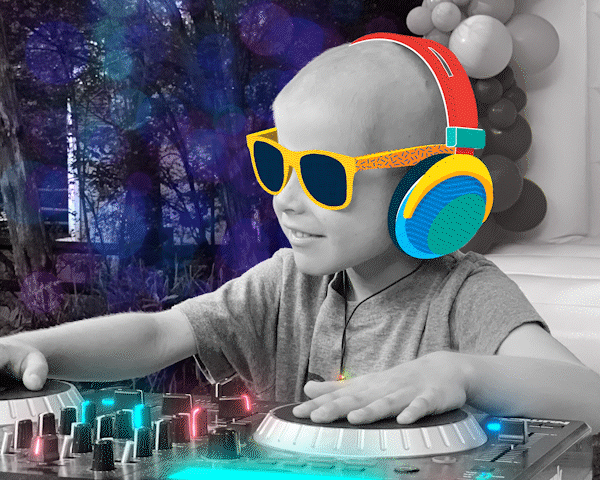
DJ Jennings at his welcome home party in June
Turns out Lauren wasn’t quite ready for them. Guests still were arriving. She had a few things to set up. Could Joel stall?
They stopped at a gas station a mile from home. At the party, Jennings would play outside, and his medications made him prone to sunburn, so Joel slathered him in sunscreen.
This was another one of those moments he’d learn to cherish. Just an everyday kid thing. Moments Joel was scared they’d never have.
Joel’s phone pinged with a text from Lauren: Everything was ready. Come home.
Joel couldn’t pull into the driveway where a giant balloon-decorated bounce house stood and a deejay played music. A huge sign in the front yard said, “Welcome home, Jennings.”
Jennings hugged family and friends; most he hadn’t seen in six months. He was so excited; he didn’t know what to do first.
“It was a lot to take in — in a good way. It was just a great way to come home,” Joel said. “It was a long road, and at times we didn’t know if we’d ever have (a welcome-home party)."
Just five minutes on the trampoline, Jennings knocked out a top front tooth.
They were home.
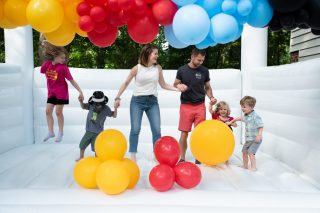
Family in bounce house at welcome home party.
Postscript:
Back at home, more than a year after Jennings’ second transplant, bone marrow evaluations and lab work show he’s still cancer-free. Every result brings huge relief.
“We focus now on life. No matter how much or how little we have…with him or with any of us for that matter. He is cured until he’s not. And that leads us to pursue life to the full for him,” Joel wrote in his blog.
“Sometimes that means going over the top to make memories and sometimes that just means letting him jump on the hotel bed.
“We don’t know how much life he’s got, so we’re determined not to waste what he has.”
Jennings gets monthly check-ups at the St. Jude affiliate clinic near their home, and he and Joel fly every three months to St. Jude in Memphis, which after so much time there feels like a second home.



